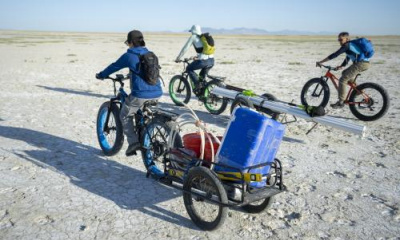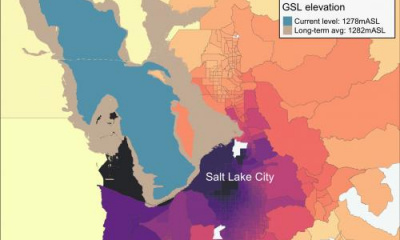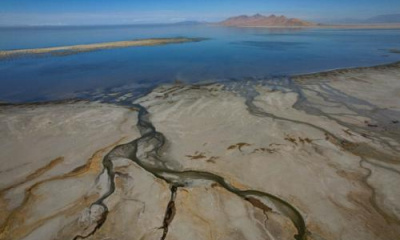Dust pollution has been relatively similar in years when lake levels were vastly different, according to data from two different federal agencies.
It’s easy to see dust blowing off the Great Salt Lake, but experts and data say it isn’t as easy to connect the drying lake’s water level to pollution levels.
Dust storms are becoming more common, one scientist said, and that trend is likely to continue.
It’s easy to see dust blowing off the Great Salt Lake, but experts and data say it isn’t as easy to connect the drying lake’s water level to pollution levels.
Dust storms are becoming more common, one scientist said, and that trend is likely to continue.
The lake isn’t the greatest source of Utah’s dust
The Great Salt Lake isn’t the biggest source of dust in Utah, said Kevin Perry, an atmospheric scientist at the University of Utah who joked he’s been called “Dr. Dust.”
It’s “not even close,” Perry said.
Desert playas where other lakes have already dried up — including the Great Salt Lake Desert to the west of the lake itself — along with gravel operations, construction and drought also cause dust storms.
The Great Salt Lake now generates around 15 dust events a year, possibly more, experts say.
But it’s hard to know for sure, since the exposed lakebed is so large, and the state doesn’t have an extensive monitoring system yet.
Dust is measured as PM10, a shorter way of saying particulate matter less than or equal to 10 micrometers in diameter.
Seven sites in Utah monitor these particles, said Phill Kiddoo, the air pollution control officer for Great Basin Unified Air Pollution Control District in California.
That’s one-third the number of sites monitoring for smaller particles, known as PM2.5, that build up during inversions and are a bigger concern for public health.
Not a clear connection between lake levels, dust pollution
There also isn’t much information about how lake levels affect dust risks, Blakowski said.
PM10 levels have varied over time, though the average has decreased since 2000, based on data from the U.S. Environmental Protection Agency.
Lake levels also have decreased in that time, according to U.S. Geological Survey data.
Dust pollution has been relatively similar in years when lake levels were vastly different.
For example, the average measurement for coarse particles was 44 in 2001 and 41 in 2008. The lake’s average elevation was about five feet higher in 2001 than in 2008.
Average measurements also were consistently 27 in 2020, 2021 and 2022 even as lake levels dropped to record lows. And the highest average measurement of coarse particles in the current millennia was in 2000.
There’s no doubt the exposed lake bed — more than 800 square miles — produces dust plumes that significantly affect air quality, Perry wrote in a 2019 research report.
Not ‘toxic,’ but a concern
But Utah Rep. Ray Ward, a Republican from Bountiful who’s also a doctor, said he hears more concerns about inversion than he does about dust.
The Great Salt Lake contains arsenic and other metals. Some are naturally occurring, while researchers say others might be human-caused.
Yet even without the lake dust, residents are “very polluted from arsenic in Utah from other sources,” Perry said.
The dust has documented health concerns, but it isn’t toxic, Perry said.
He didn’t dismiss health concerns, but said the word “toxic” causes people to panic.
It’s more accurately a “contaminant of potential concern,” Perry said. That’s a “contaminant which may or may not be causing risk or adverse effects to the plants and animals at a site,” according to the Environmental Protection Agency.
There’s uncertainty about how much exposure people are getting to arsenic and other potentially harmful contaminants, and about exactly what the dust is doing to the health of millions of people living on the Wasatch Front.
The state needs more monitoring for PM10, Perry said.
More water is the solution
Perry does advocate for saving the Great Salt Lake and increasing water levels, including as a solution for dust.
“The most effective way to prevent dust is to put more water back in the lake,” Perry said.
That’s a lesson learned from California’s Owens Lake, a dry lakebed within the bounds of the Great Basin Unified Air Pollution Control District.
Controlling dust from the 50 square miles of lakebed — a small fraction of the Great Salt Lake’s surface area — cost $2.5 billion upfront, Kiddoo said. There’s also an annual cost of $25 million to $50 million, he said.
Utah is at an advantage, Kiddoo said, because the Great Salt Lake still has water.
“At Owens Lake, we haven’t had water for more than 100 years,” he said. “All we’ve had is toxic dust.”
Owens Lake went dry about 13 years after water diversions from Owens River to Los Angeles.
The use of diverted water is the largest cause of the Great Salt Lake drying up, Perry said, though climate change and drought also contribute.
That makes being proactive important, Ward said, because people become accustomed to using a certain amount of water.
“Once people get used to using water, they’re not going to not use that water easily,” Ward said, even if there are other health concerns.







